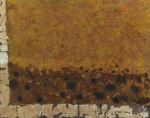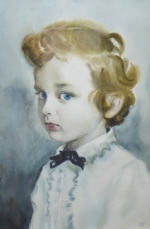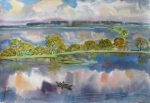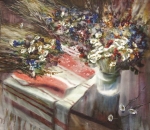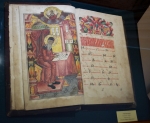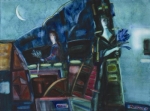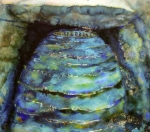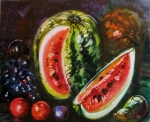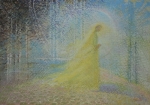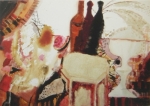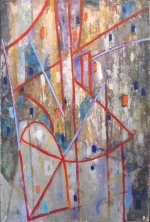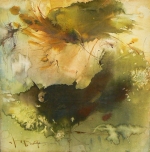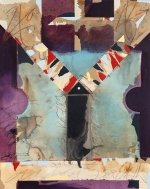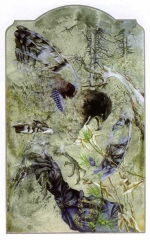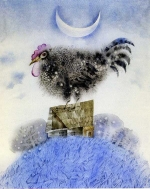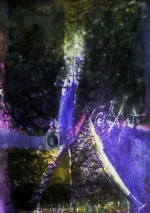"Perfect rare was popular"
Johann Wolfgang von Goethe
...background ...
I am surprised that there are still people who prefer visiting exhibitions instead of staring at their smartphones or TVs. Moreover, even among them there are very few ones for whom the word "aquarelle" is not associated with “mackerel”. Such people are worth being protected and multiplied. So, we will try to do it.
Replica for colleagues: of course, now it is impossible to compare the technologies and means of expression. The basis of any art is the artistic vision. It is clear and not discussed, but traditional technologies also exist objectively. So, here we are talking about what we see.
…In general ...
If you are still reading this text the origin of the term "aquarelle" is no a secret for you. The term was borrowed from French and has the Latin roots – “aqua” means “water”. Indeed, the watercolor - is the "water" paint and the process of painting. White is too dense paint for this technique and traditionally rare used. Whiteness of paper is used instead of the color.
According to Dictionary of Fine Arts the watercolor’s features are: "extremely small pigment particle size and a large rate of adhesive substances as base... The most important feature of watercolor painting - transparency and softness of the paint layer ... the possibilities of this technique is quite wide, but the difficulties significant… "
Let’s talk about the classification of watercolor: is it painting or graphic. (And who is guilty for such small interest during the recent time.)
You know that watercolor usually uses paper. Apparently, some museums class watercolors as “Graphic” as the paper has its own conditions for storage.
Some artists also use this classification. If you use paper – you are a graphic. And what would you say to say about the artist who puts paper on canvas as Alexander Konovalov from Polotsk? This dilemma can make a museum worker crazy. Nevertheless, most of artists would tell you that watercolor is the part of classical painting. Not even because of the first years of “watercolor painting” in all classical art educational institutions (in former USSR countries at least). The root of the problem is deeper. You agree that the “painting” based not on shape, line, lite or shadow. The main idea is color! Ignoring details, we can say that watercolor is the same painting even with the same colors, but the colors have the different basis.
To make the experiment we “inspect” a number of books about Belarusian art – from huge albums ("Modern Belarusian art", published by Belarusian encyclopedia named after P. Brouka, Minsk, 2010, 432 pages.; "Art of Belarus" Galart, MA, 2010 216 pages) and ending with large catalogs of exhibitions. In most cases, usually when the Belarusian Union of Artists prepares the book, the watercolor is treated as graphics.
Moreover, the problem isn’t that we must “sort” watercolor. No. IMHO the point is that watercolor worth more attention. Argues:
Life example: A painter says watercolorist "Why do you use this watercolor. Use oil. Don’t you need money?.."
When a buyer in art-shop buys a picture by a famous artist, he doesn’t think that 99% of the price is the name of the author. But if to choose between poorish oil canvas and excellent watercolor most of our people don’t think about skills of the artist and prefer oil painting.
For the record: In 2007, gallery Tate Britain purchased from a private collector watercolor by William Turner "The Blue Rigi" for 4.95 million pounds (then it was equivalent to $ 9.8 million).
Constant race of curators (at least at the post-Soviet space) for something "new" and "hot" minimized the value of classical materials. People forget that watercolor can be just loved. There often appear misguiding thinking.
Of course, our "classical" museums don’t ignore watercolor. In every state museum you can find a line of good watercolors. Now the number of artists that use this technique is extremely limited, and thus the exhibition, bringing together such artists is only one - the Polotsk Biennale of watercolor "Vada + Farba (Water + Colour)". The same problem is with printing editions.
For reference, in our days, the biggest event in the world of watercolor is a Belgian exhibition ASBL Salon de l'Aquarelle de Belgique. This show was first organized in 1989 to promote watercolor painting in Belgium and the search for new talents. The project was successful and the exhibition was visited by a little less than 7,000 visitors. In 1990 the School of watercolor Namur was organized. Now the school is engaged in about 300 students. In 1995 this show involved artists from Austria, France, Russia, Poland, Spain, Italy, China, India, Canada and the United States. Since 2011, the main space to perform the show is Namuro Expo. The exhibition is held every two years. It is attended by more than 200 artists from 20 countries. The Salon uses more than 250 rooms for a variety of exhibits and workshops. The official website for salon ASBL Salon de l'Aquarelle de Belgique - www.salon-aquarelle.be
...about the technology ...
Among the watercolor artists, there is a constant debate about the problem of the "purity" of technology: if the artist should use the classic set of watercolors or some combinations are allowed. On the one hand, each change of technique from the first glance looks new and strange, but in a time it is treated as a usual one. On the other hand – the speed of the development is so high that without a certain reasonable "containment" it can simply "disappear". There are many points of view but I would like to emphasize the idea heard during a conference at the 4th International Biennial of Polotsk watercolor "Water + Color". Ukrainian artists proposed to set up a section of "experimental watercolor". To my mind this proposal is very rational way to reconcile the artists of the classical and experimental watercolor.
Mistake 1 "watercolor has fewer opportunities"
Very often, this mistake is connected to the complexity to make changes in watercolor. I would say that the watercolor has more opportunities than dangers. The skilled artist can do every motif, a realistic one as well as abstract. Do you want a credibility of form and materiality of objects – there is Gennady Shutov; want something unusual - not a problem, there is Valentina Liakhovich. There are vivid, color-based watercolors by Zoja Litvinova. The mistake is to treat watercolor as conservative technology. Modern Belarusian watercolor long ago passed the classical shape and develops together with the artistic thought (message, idea). Technical arsenal is wide and is constantly being improved by experiments.
Mistake 2 "watercolor is easier than oil painting".
It is a common mistake as this technique is used in the school. Many people threat the first step, as a "children" one. On the contrary. Watercolor immediately shows the level of a painter. (not to hurt oil-painters). To create a good watercolor a painter must "perfectly" now technology, and at the same time to work rather quickly. Also keep in mind that the important role to select watercolors as the first stage in art education is the cost of materials and the simplicity of the equipment.
Mistake 3 "poor safety of watercolor ".
To tell the truth – from the point of view of a museum worker – to save watercolors during the years is a little bit more complicated than oil painting. But this information is mostly for museum workers. Modern watercolors can live more than most of us. Do not believe? Go into any historical museum and look at the manuscript folios, decorated with watercolors miniatures and initials made centuries ago... Or look at the sketches by Albrecht Durer of 15-16 centuries. (in a good safety); or watercolors by Anthony van Dyck of the 17th century ... watercolors in the halls of the Russian Academy of Arts dated 150 years ago... watercolors by Mikhail Vrubel at the Kiev Museum of Russian Art ... etc. There are a lot of examples. Not many people know that both watercolor and oil paints use nearly identical pigments, and very mostly with basing agent. Improper storage (direct sunlight, excessive humidity, corrosive environments, dust) is equally dangerous for both watercolor, oil, acrylic … and even stainless steel. Why do you think museums prohibit flash photography? Because the flash light hurts painting.
Mistake 4 "I do not want to use glass."
The classical watercolor framing with glass has many assumptions. Of course, the paper will be better protected from dust and dirt, and, from a responsible householder wit wet duster. In addition, the sheet of paper will be straightened. There are extra benefits. The glass transfigures the work, adds new “sounds” to the colors… And those who does not like glass can use plastic, which also can be anti-glare.
...persons...
Here, we will not tell you about all Belarusian watercolor artists*. We name just some bright persons who permanently or periodically uses watercolor.
* Selection of the artists and annotations are subjective vision of the author and may be corrected in future.
The review of the most well-known watercolor brands was made by our friend-website wonderstreet.com and can be found here>>>
|
|
Philip Basalyga - a young artist from Minsk. Periodically turns to watercolor. Works in figurative composition. |
|
|
Nicholay Buschik - artist from Minsk. Oil painter, but periodically uses watercolor. His works are bright, vivid and rich of color. Even realistic motifs he makes with high generalization. |
|
|
Vladimir Vishnevsky - artist from Minsk. Works mostly in the easel graphic. Periodically uses watercolor. Works at Belarusian Academy of Art. |
|
|
Felix Humen - the artist from Vitebsk. During a long period worked in Vitebsk Pedagogical Institute. Prepared many modern Belarusian watercolor artists. Known as realistic artist but recently makes abstract experiments. His marker is "scraping" of wet color. |
|
|
Alexander Karpan - artist from Vitebsk. Works as realistic watercolor artist. Favorite genre - still life. |
|
|
Fedor Kiselev - artist from Mogilev. Works "on wet" (a la prima) mostly in the genre of realistic landscape, often in a limited palette. |
|
|
Svetlana Katkov - artist from Minsk. Works mostly in figurative compositions. Periodically uses watercolor. |
|
|
Svetlana Kurashova - artist from Gomel. Works in easel compositions as well as in realistic still-life. In compositions she creates a complex multi-layered texture close to the ancient frescoes (including damage of paper and color). |
|
|
Irina Loban - artist from Minsk. Currently works mostly in book illustration. |
|
|
Valentine Liakhovich - artist from Vitebsk. Completely abandoned the traditional framework of working with watercolor. Uses watercolor in combination with other paints. Uses collage. Creates a three-dimensional watercolors (columns), huge sheets (a few meters). Works mostly in abstract art and figurative compositions. |
|
|
Vyacheslav Pavlovets - artist from Minsk. Works primarily in the genre of realistic landscape. |
|
|
Sergey Pisarenko - artist from Minsk. His works have complex, multi-layered textures. Works in the genres of landscape, still life and easel compositions. (In recent years uses mostly oil painting.) |
|
|
Vladimir Rynkevich - artist from Minsk. Works in watercolors in various genres. Widely uses methods of monotypes, tack, flushing. Published the book "The Art of watercolor" where he makes a lot of useful advises for students as well as for a wide range of readers. |
|
|
Andrey Savich - a young artist from Minsk. Works mostly as an abstract artist. Periodically uses watercolor. |
|
|
Valentina Sidorova - artist from Minsk. Has a wide creative range. Periodically uses watercolor. |
|
|
Pavel Tatarnikau - artist from Minsk. Outstanding illustrator. Actively uses watercolor. |
|
|
Rita Timokhova - artist from Minsk. Works primarily in watercolor painting and book illustration. |
|
|
Antonina Faley - artist from Vitebsk. Works as abstract artist. Periodically uses watercolor. |
|
|
Gennady Shutov - artist from Vitebsk. Master of glazing (multilayer) watercolor. Known as a realistic artist. |
And this is not a complete list. There are Oleg Kostogryz, Victor Shilko, Mikhail Lewkowich, Alexander Shienok, Vikentij Raltsevich, Alexander Konovalov, Irina Shutova, Svetlana Vrubezevskaya, Vladimir Napreenko, Igor Shkuratov, Igor Khaikov, Valery Chukin, Ivan Stolyarov, Mikhail Nehaichik and many others.
There are used illustrations provided by the artists, Polotsk art gallery, materials scanned from catalogues, taken from open Internet resources as well as the photos made by the author.



